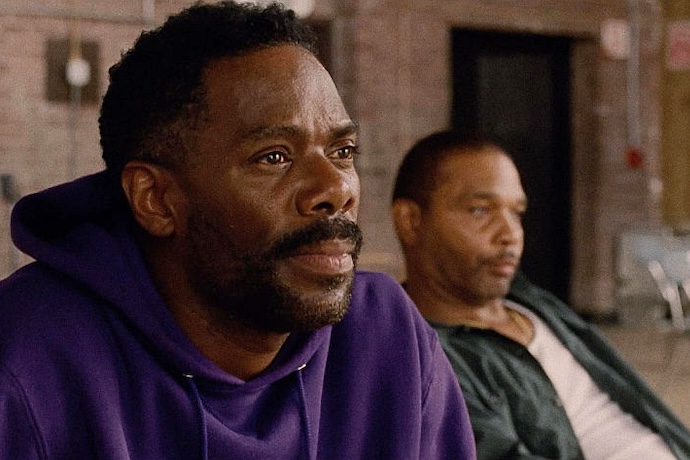The prison occupies a powerful place in the American imagination. In film and television it offers a context through which to explore the worst imaginable qualities of humanity—the dangerous, monstrous, deranged, and obscene. The stereotypes, fantasies, and voyeuristic consumption promoted in popular media feed into the same dehumanizing logics peddled by carceral institutions themselves, allowing viewers to imagine prisoners as caricatures provoking pity, condescension, or fear.
Presumably, the answer to this trend is to humanize: to promote narratives that situate the incarcerated as complex human beings, emphasizing their agency and resilience. Greg Kwedar’s independent film, Sing Sing (which is being re-released this month, with an eye toward winning more awards) offers a powerful example of the humanizing prison narrative and its potential for social change. However, it is worth asking whether even humanizing narratives risk reinforcing the same carceral logics as their more callous predecessors, and whether meaningful change is something we can realistically expect them to promote.
Sing Sing tells the story of perseverance amid debilitating circumstances. It’s moving, enraging, and uplifting, offering insight into the experiences of incarcerated men working to assert their humanity within denigrating systems. It speaks to the power of artistic creation; of community-building; of hope and persistence. But I found myself wondering, during a Philadelphia Film Society screening, how we might interpret these messages of optimism and perseverance despite the odds. Do they invite us to challenge and reimagine dominant understandings of justice disseminated through our penal systems? Or do they assure us instead that oppressive systems must be met with patience, that progress will come to those who wait?
Inspired by true events, the film follows Divine G (Colman Domingo) who, we gradually learn, was sent to Sing Sing for a crime he did not commit. We see him work to support other incarcerated men and prepare for his upcoming parole hearing as he navigates the daily indignities of carceral life. Despite the systemic injustices that keep him behind bars, Divine G finds purpose through his participation in a theatre program (based on Rehabilitation Through the Arts, or RTA) which offers a site of connection and expression, a small but significant reprieve from the pervasive violence of incarceration. As a testament to the power of the program, many of Sing Sing’s actors are real-life alumni of RTA.
Critics agree that Sing Sing benefits from Kwedar’s insightful direction, as well as from powerful acting by both professional and non-professional actors, several of whom won Gotham awards last month. Many praise the film’s empathetic, nuanced glimpse into the lives of the incarcerated, while others commend it for refusing to spectacularize carceral brutality. Given the rarity of stories from the “inside” gaining traction in popular media, I’m tempted to join those extolling Sing Sing as an exemplar, maybe even a sign of potential for real social progress. At the same time I wonder what kind of impact we might realistically expect this kind of narrative to have within a political landscape that unequivocally affirms the immutability of the prison as a foundational element of American life.
Ironically, perhaps, some of the most dramatic expansions of the carceral state have taken place under the guise of supporting prisoners: offering better programming, creating greener spaces, providing more rehabilitative resources. While implemented with good intentions to ameliorative effect, these reforms demonstrate that you don’t need to support “tough on crime” politics to support increased state investment in prisons. They indicate that the cultivation of empathy and humanitarian interests do not always lead, de facto, to harm reduction.
A prison with more art classes, a bigger campus, and a denser library is still a prison. As Sing Sing shows, even when prisoners have access to these resources, the violence of incarceration—the familial separation, the arbitrary cell searches, the exploitation of vulnerable populations—persists.
During a post-screening Q&A with RTA alumni, one man professed that participation in other rehabilitative programs “did nothing for [him].” RTA was different, he suggested, because it was founded by incarcerated people; it isn’t a structured, one-size-fits-all approach to rehabilitation, but a dynamic, self-made community where men endeavor to build something directly responsive to needs and interests within their localized contexts. It took the program nearly eight years to gain “legitimacy” at Sing Sing, overcoming a series of administrative obstacles. Needless to say, this was not a top-down initiative; it was a project developed despite the efforts of the carceral apparatus.
This background is important. It positions the prison as a hindrance—not a catalyst—to rehabilitation. It emphasizes the importance of self-direction and collective agency against an environment designed to crush individual and group empowerment. RTA functions as an exception to incarcerated life, precisely because it refuses to replicate the abasing logics of the prison. Within the film, the theatre program isn’t branded as a “solution” to the problem of carceral violence and injustice, but as a site of something else; a fleeting experience of life otherwise, evading the prison’s dominating structures.
But it’s difficult to surrender the search for bureaucratic rather than more subversive solutions. Indeed, a post-Q&A call to urge legislators to fund theater programs in prisons nationwide seems to undermine the subversive potential of Sing Sing, suggesting, as so many have before, that carceral expansion will alleviate carceral violence. It’s this kind of circular logic that fuels my pessimism regarding the cultural impact of Sing Sing. The question here is one faced by many activists and reformers: Should we filter all visions of justice through what we believe is imminently achievable or should we offer a framework for fundamental change?
The humanizing narrative holds affective power, but this seldom translates to social transformation. Empathy—however genuinely felt—does not function as a substitute for real political engagement; it doesn’t even demand that we question the foundations of our carceral systems. A sense of connection with the plight of an afflicted individual cannot counteract the fact that our social structures are designed to condition even the most well-intentioned among us to reproduce systems of harm.
When we identify a deeper investment in carceral structures as the answer to the violence of incarceration, we participate in this social reproduction. It’s not a matter of changing perspectives to embrace the humanity of the imprisoned, but of deconstructing the epistemological frameworks that allow us to believe that a simple recognition of humanity is the ultimate endgame of prison reform.
While Sing Sing offers a beautiful testament to the power of the human spirit, I don’t think it represents the beginning of a new kind of conversation around criminal justice. Maybe we need to discard the idea that we can “convert” society through stories showcasing prisoners’ humanity. Maybe individual change—whether in the behavior of the convict or in the hearts and minds of the audience—has taken too much of a central focus in our conversations around prisons. Maybe we have to instead imagine transformation on a deeper scale, thinking against the interests of the carceral state to envision collective practices of justice ingrained in a fundamental recognition of human dignity.
Sing Sing is well-deserving of its accolades; it successfully conveys the humanizing message it sets out to deliver. I just hope we can take this message as a starting point for working toward justice-oriented change—not the end goal.


